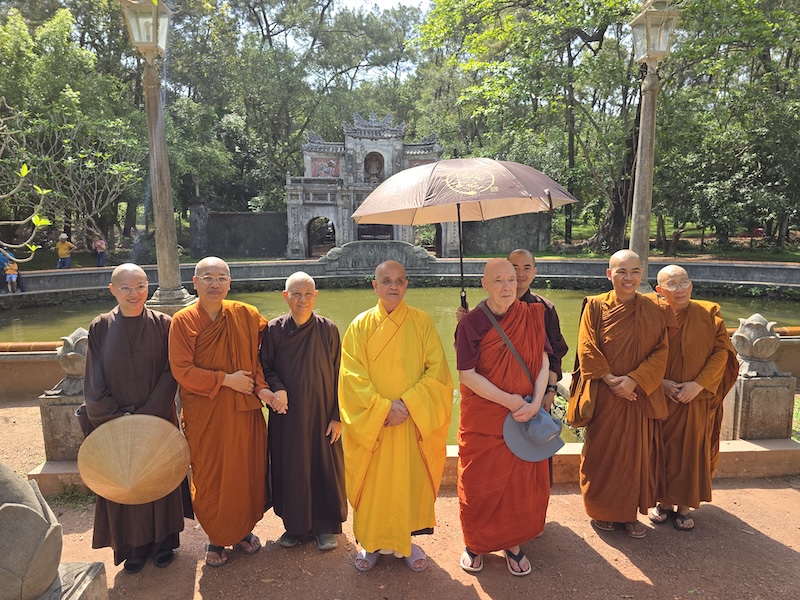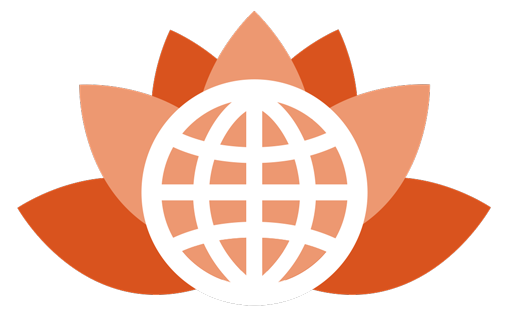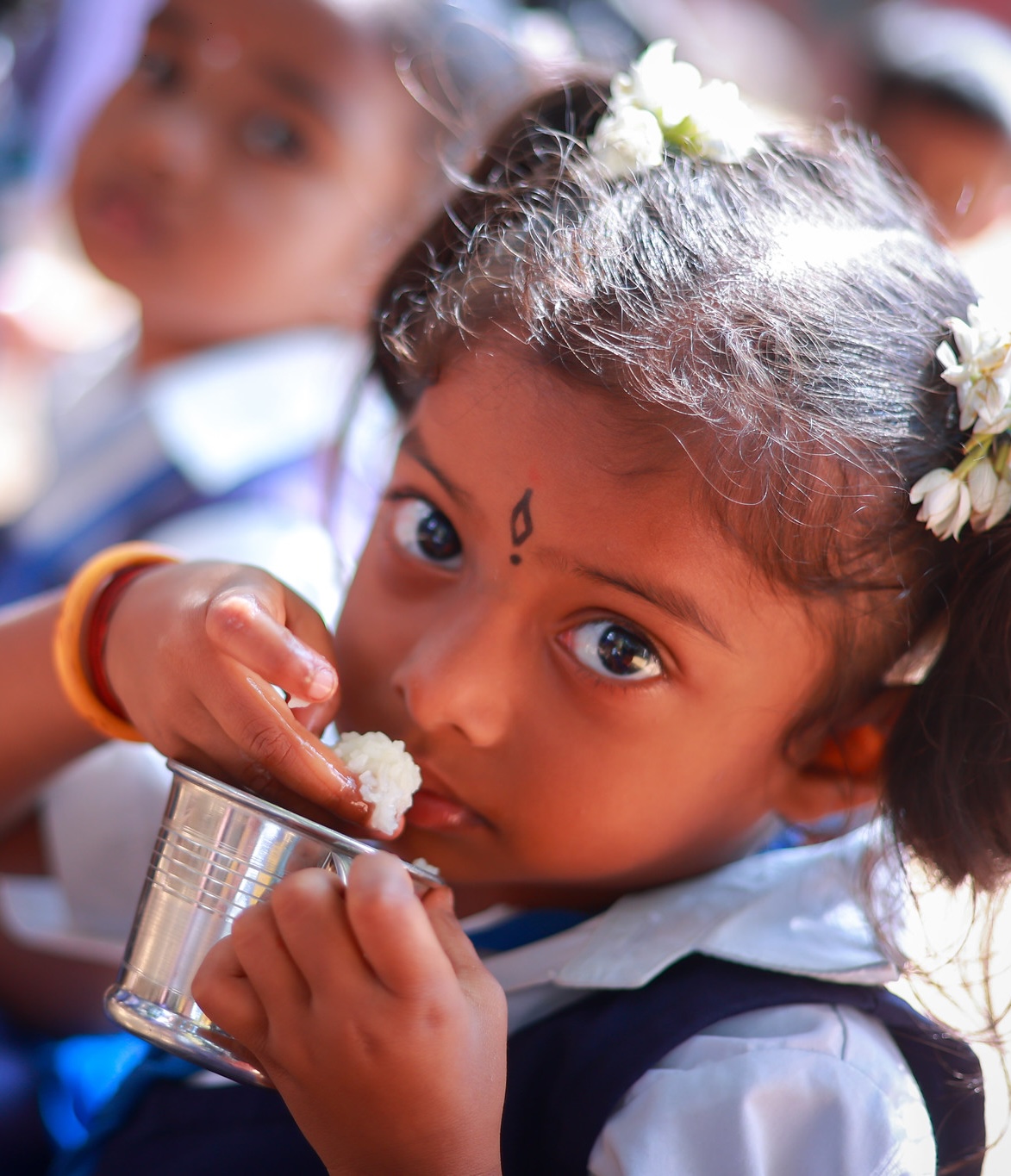Ven. Bhikkhu Bodhi with monastics at Half Moon Pond at Thich Nhat Hanh’s root monastery, Chua Tu Hieu, on the outskirts of Hue.
By Ven. Bhikkhu Bodhi
On May 6, 2025, BGR founder and chair Ven. Bhikkhu Bodhi gave the keynote address at the UN International Day of Vesak celebration, held in Ho Chi Minh City, Vietnam. The full text of his address, titled “Protecting Human Dignity from the Threat of Moral Nihilism,” can be read here. The following is a personal account of Bhante’s travels in Vietnam leading up to the UN event.
When I was in India this past February, I received an email from the UN International Day of Vesak organizing committee inviting me to join the UN celebration of Vesak, which was to be held in Ho Chi Minh City, Vietnam, from May 5 to 8. In years past I had been invited several times to join this event, but I had always been reluctant to make the long journey to Asia just to celebrate Vesak for three or four days. But this time, since I was already in Asia, I decided to accept the invitation. When I informed the organizing committee that I would join the celebration, they replied with a request that I give the keynote address on May 6.

Outside Chua Giac Minh, where I lived for two months in 1972.
I was also excited about the opportunity to revisit Vietnam. I was originally ordained as a novice monk in the Vietnamese Mahayana tradition in 1967, under a Vietnamese monk studying with me at Claremont Graduate University. When I left the U.S. for Sri Lanka in 1972, I stopped off in Vietnam and spent two months with my first teacher at the Giac Minh Pagoda, his small temple in Saigon. This was during the Vietnam war, and while staying at the temple, on many nights I would hear war planes flying overhead, bombs exploding in the distance, and occasional bursts of gunfire. After I left Vietnam for Sri Lanka in October 1972, I had never been back.
This time I found Vietnam to be an entirely different country: peaceful and non-aligned; overwhelmingly young; officially communist but sustaining a thriving, vigorous, energetic mixed economy. Since I had never seen northern Vietnam, I decided to go first to Hanoi and spend a couple of weeks before the Vesak celebration sightseeing in this part of the country. I arrived in Hanoi on April 23, on a flight from Bali via Singapore. When I reached the arrivals hall of the Hanoi airport, I was surprised to find a group of Vietnamese Buddhists waiting for me with bouquets of flowers. I was truly astonished by this warm welcome, which lifted my spirits.
The welcoming team brought me to Long Hung Monastery, a large monastery on the outskirts of Hanoi, which was to be my temporary base. Long Hung probably goes back centuries, but it has been recently renovated and now accommodates many monastics and a large congregation of lay devotees. Currently, the monastery also hosts a team of scholars—monastic and lay—who are translating the major texts of all Buddhist traditions into Vietnamese. These include the Pali Tipitaka, the Chinese Tripitaka, and the Tibetan Kanjur, as well as non-canonical sources. They have already completed a multi-volume translation of Indian and Chinese texts of the Pure Land tradition. The Pali translations are supervised by Bhikkhuni Dhammananda, who was trained in Myanmar and Sri Lanka. In the photo at the reception room (below), she is second from the left. Bhikkhuni Lieu Phap, who organized my itinerary and accompanied us on our travels, is next to her, third from the left. The tall monk to my right is the abbot.

Reception at Long Hung Monastery.
I spent the night in a comfortable guest room at Long Hung Monastery. The next day, after breakfast, a group of lay devotees took Ven. Lieu Phap and me on a trip to Ha Long Bay, a UNESCO World Heritage site on the northeast coast of Vietnam. Along the way, we stopped off at Truc Lam Yen Tu, the Bamboo Grove, a mountain complex that had been the base of the Tran dynasty king, Tran Nhan Tong (1258–1308), who renounced the throne to become a monk. He founded the Truc Lam Zen School, which advocated the integration of Dharma practice into everyday life. We took cable cars up the mountain to the lower terrace, and from there walked in stages up successive higher levels until we reached the shrine containing the relics of the monk-king. These heights offered breathtaking views of the mountainous countryside of northeast Vietnam.
After the meal and some light conversation, we continued on to Ha Long Bay, “the bay where the dragons descend.” The bay contains over 1,900 limestone islands which rise up from the water like strange creatures rising from the deep. In the early morning, as fishing boats drift by in the distance, the bay looks like a Chinese painting from the Yuan dynasty. On the day after our arrival, we hired a boat to take us around the bay, stopping at one of the larger islands to explore a huge winding cave.
We returned to Long Hung Monastery in Hanoi on the evening of April 26, and the next morning I gave a public Dharma talk attended by about 700 people. This was followed by an exhausting session of book signing, as the Vietnamese translation of my anthology, Noble Truths, Noble Path, had just been issued days before. In the afternoon, I had a conference with the translation team of Long Hung where we discussed various problems arising from translation. The following morning we visited the National Vietnam University’s Hanoi branch and met some of the professors.

After public Dharma talk at Long Hung Pagoda.
On April 29, we flew from Hanoi to Hue, where we stayed at a tranquil Theravada forest monastery about twenty minutes from the city. The next day we paid a visit to Thich Nhat Hanh’s root monastery, Chua Tu Hieu, on the outskirts of Hue. Here, we offered flowers at the memorial altar for Thich Nhat Hanh and visited the Thich Nhat Hanh Memorial Hall, the Bhikkhuni Training Monastery, and the Half-Moon Pond, his favorite spot at the monastery. Following this visit, we went to a Theravada monastery in Hue city for the mid-day meal, and after a long rest, in the late afternoon we visited the old royal palace, beautifully renovated. We next took a boat ride down the Perfumed River to the Thien Mu Pagoda, alongside the river, which features a seven-story tower. The temple also preserves the car that had been used to drive Ven. Thich Quang Duc to the crossroads where he immolated himself in 1963. The photo of the meditating monk engulfed in flames is one of the landmarks of photography in the twentieth century.
From Hue, we drove down to Danang, now a thriving commercial city, with high-rise apartment buildings, five-star hotels, lavish restaurants, beach resorts, and world-class shopping malls. The next day we continued down to Hoi An, about an hour further south. Hoi An is an old commercial port where, in past centuries, merchants and travelers from different countries and cultures used to meet and mingle. The city has a festive atmosphere all year round. A small river runs through the middle of the city, with boats offering tourists rides, and the colorful streets are decked with lanterns, food stalls, and souvenir shops. The city offers a nightly show, Memories of Hoi An, described as “the world’s largest outdoor show featuring more than 500 performers, a unique fusion of music, scenes, and dance in a vibrant performing arts production.” The next day, May 3, we returned to Danang, where we took a flight to Ho Chi Minh City.
I spent the night of May 3 at the Buu Long Monastery, a large Theravada monastery about an hour from the city center. The next day, we made a day trip to Vung Tau. We drove first to Ven. Lieu Phap’s own monastery, Suññata Arama, an impeccably designed forest monastery for bhikkhunis, with separate kutis for meditation and a spacious Dharma hall. Here I gave a talk on the case for the revival of the Bhikkhuni Sangha. After the meal, we stopped at another bhikkhuni monastery in the Vung Tau region and then visited Vung Tau itself. I remember Vung Tau in 1972 as a quiet vacation resort, with only a few small rest houses and a lengthy beach; at the time it was almost deserted. Now Vung Tau is swarming with hotels, restaurants, guest houses, tea and coffee shops, and beach resorts.
We returned to Buu Long Monastery that evening, and the next afternoon, May 5, we drove into Ho Chi Minh City to prepare for the UN Vesak Celebration. After registering at the Eastin Grand Hotel, we headed to a special reception for VIP delegates—since I was to be the keynote speaker, I was considered a VIP. We were received by the Supreme Patriarch of the Vietnam Sangha, Most Ven. Thich Tri Quang, and were then led to the exhibition of the heart relic of Ven. Thich Quang Duc. The walls of the hall featured photos of the other monks, nuns, and lay Buddhists who had immolated themselves during this tumultuous period of Vietnamese history. We were then brought to a grand reception, with a sumptuous dinner (which, in accordance with monastic precepts, I didn’t eat!) and performances by Vietnamese musicians.

With Bhante Sanghasena of the Mahabodhi Meditation Center in Ladakh.
The main Vesak events started the next day, at the Buddhist University of Vietnam, which has a huge sprawling campus that extends for several city blocks. We needed a motorcart to get from the entrance to the main building. The foreign delegates were an extremely mixed group. They included monks from the traditional Buddhist countries—Thailand, Sri Lanka, Myanmar, Nepal, Korea, Cambodia, and India; and delegates from Spain, Brazil, Russia (Mongolian Buryatia), Pakistan, the U.S., and Uganda. I was delighted to meet several good monastic friends, including three with whose organizations Buddhist Global Relief has partnerships: Bhante Sanghasena of the Mahabodhi Meditation Center in Ladakh, Bhante Ananda of the Mahabodhi Society of Bengaluru, and Bhante Buddharakkhita of the Uganda Buddhist Center.
Government representatives had prominent speaking slots on the opening morning. The president of Vietnam, Lương Cường, and the president of Sri Lanka, Anura Dissanayake, both gave good speeches. On the afternoon of May 6 I gave the keynote address. The theme of the Vesak celebration was “Unity and Inclusivity for Human Dignity,” so the topic I chose for my talk was “Protecting Human Dignity from the Threat of Moral Nihilism.” I explained how today the idea of human dignity is under threat from four sources of “moral nihilism”: a predatory form of capitalism that prioritizes profit over human well-being; the invasive role of electronic media in our lives; the drift toward authoritarianism and autocracy in many countries; and the breakdown of the global rules-based order in wars that intentionally target civilians. I also offered ideas about the values we need to resist this drift toward moral nihilism. The full text of the speech can be viewed here.
Alongside the UN Vesak celebration, Buddha relics brought from India were put on display at Thanh Tam Pagoda—a large monastery adjacent to the Vietnam Buddhist University—which gave the general public the chance to pay respects. The relics were kept in a casket in a shrine at the center of the main hall. The line of devotees wishing to worship the relics extended as far as the eye could see. There may have been over 10,000 people waiting on that night alone, and the exhibition continued here for several days and was then brought to Ba Den Mountain and later to Hanoi.

Vesak celebration in Ho Chi Minh City.
On the evening of May 6 thousands of people had assembled on the grounds of the university for the public celebration of Vesak—which was distinct from the UN celebration held during the day and reserved for invited delegates. This public celebration was conducted in grand fashion, with a candlelight procession around a small lake adorned with artificial lotus flowers and a large statue of the Buddha on the stage, where monks gave short sermons in English and Vietnamese and led devotional chanting. On May 7, the Vesak gathering continued with panel discussions on various themes by academics and practitioners both in the morning and afternoon.
After spending just three weeks in the country, I came away with the impression that Buddhism in Vietnam is quite healthy, even thriving. The faith and devotion of the Buddhist population moved me deeply, and I was glad to see that many Vietnamese lay Buddhists seriously study the Dharma. The monasteries we visited seemed to be flourishing, and it was encouraging to see that they’re attracting young people to monastic life. In several of these monasteries, I saw dozens of monks and nuns in their 20s and 30s. Many monastics have completed university studies and hold master’s and even doctorate degrees. Some have studied in Sri Lanka, Thailand, India, Myanmar, and Taiwan—probably Japan as well.
While it may be the case that the government supports Buddhism in order to win the loyalty of the Buddhist population, I didn’t get the impression that it is cynically using monks and monasteries merely to establish control over the people or to advance its political agenda. It seemed to me that the government allows the monasteries to carry on with their religious and scholarly activities unhindered, even supporting them financially, as long as the monastics remain within the boundaries of religious life and don’t become involved in politics. Whether they completely agree with government policies or not, the monastics seemed to be content to let the government manage the political and economic spheres of Vietnamese life as long as they are free to carry out their religious activities without coercion or interference.
On the day of my flight, our host family took me and another American bhikkhu, Ven. Sanathavihari (from Los Angeles), for lunch at an elegant vegetarian restaurant called Hum Signature. The restaurant is just a short walk away from the Vietnam War Remnants Museum, so after the meal we paid the museum a visit. This visit delivered a horrid reminder of the death, trauma, and destruction that the U.S. inflicted upon Vietnam during the 1960s and 70s. But the museum also honored a few American heroes, such as Lawrence Colburn, whose testimony before the Peers Commission exposed the terrible My Lai massacre of 1968.
My special thanks are due to Bhikkhuni Lieu Phap, who meticulously planned my itinerary in Vietnam, and to the Vietnamese supporters who sponsored and accompanied me on my travels: Tôn Nữ Quỳnh Giao, Tôn Nữ Quỳnh Như and Trần Hữu Tâm, their children, Trần Hữu Minh and Trần Quế Phương, Upāsikā Sumangalā, and Sumanā An Phương.
For more photos of Bhante’s visit to Vietnam, use this link to see his Google Album.





